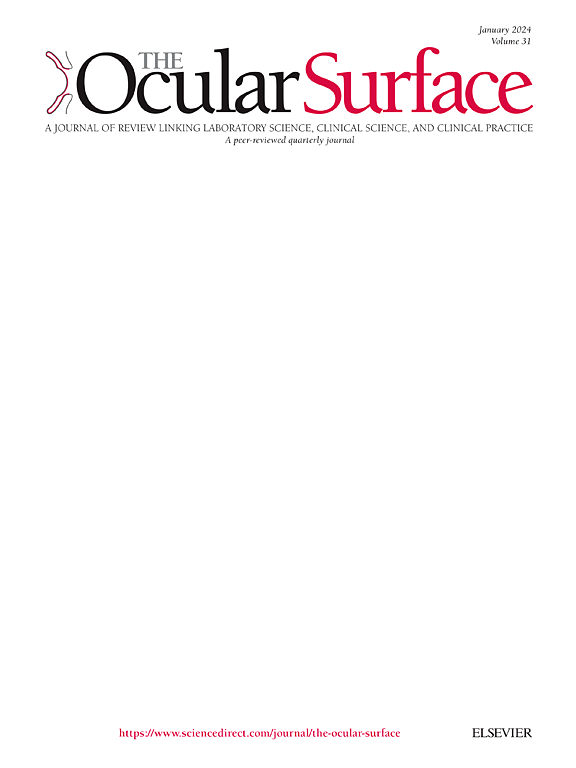Pard3 promotes corneal epithelial stratification and homeostasis by regulating apical-basal polarity, cytoskeletal organization and tight junction-mediated barrier function
IF 5.6
1区 医学
Q1 OPHTHALMOLOGY
引用次数: 0
Abstract
Purpose
To document the expression of apical-basal polarity (ABP) determinants in the mouse corneal epithelium (CE) and elucidate the functions of Pard3 in establishment and maintenance of ABP, stratification, homeostasis, and barrier function in the CE.
Methods
Pard3Δ/ΔC mice (Pard3LoxP/LoxP; Aldh3A1-Cre/+) with cornea-specific Pard3 ablation were generated by breeding Aldh3A1-Cre/+ with Pard3LoxP/LoxP mice. The control (Aldh3A1-Cre/+ or Pard3LoxP/LoxP alone) and Pard3Δ/ΔC corneal histology, ocular surface properties, barrier function, and actin cytoskeleton were assessed by Haematoxylin and Eosin staining of paraformaldehyde-fixed, paraffin-embedded tissues, scanning electron microscopy, fluorescein staining, and phalloidin staining, respectively. The expression of specific markers of interest was evaluated by qRT-PCR, immunoblots and immunofluorescent staining.
Results
Dynamic changes were observed in the expression and localization of ABP determinants as the CE stratified and matured between post-natal day 5 (PN5) and PN52. Adult Pard3Δ/ΔC CE contained fewer cell layers with rounded basal cells, and loosely adherent superficial cells lacking microplicae. Adult Pard3Δ/ΔC CE also displayed impaired barrier function with decreased expression of tight junction, adherens junction, and desmosome components, disrupted actin cytoskeletal organization, increased proliferation, and upregulation of transcription factors that drive epithelial-mesenchymal transition (EMT).
Conclusions
Disruption of ABP in Pard3Δ/ΔC CE, altered expression of cell junction complex components and disorganized actin cytoskeleton, increased cell proliferation, and upregulated EMT transcription factors suggest that the ABP-determinant Pard3 promotes CE features while suppressing mesenchymal cell fate. Collectively, these results elucidate that Pard3-mediated ABP is essential for CE stratification, homeostasis and barrier function.
Pard3 通过调节顶端-基底极性、细胞骨架组织和紧密连接介导的屏障功能,促进角膜上皮分层和平衡。
目的:研究小鼠角膜上皮(CE)中顶基极性(ABP)决定因子的表达,并阐明par3在角膜上皮中ABP的建立和维持、分层、稳态和屏障功能中的作用。方法:Pard3Δ/ΔC小鼠(Pard3LoxP/LoxP;Aldh3A1-Cre/+与Pard3LoxP/LoxP小鼠杂交产生具有角膜特异性par3消融的Aldh3A1-Cre/+。对照(Aldh3A1-Cre/+或Pard3LoxP/LoxP单独)和Pard3Δ/ΔC分别通过多聚甲醛固定组织、石蜡包埋组织的Haematoxylin和Eosin染色、扫描电镜、荧光素染色和phalloidin染色来评估角膜组织学、眼表特性、屏障功能和肌动蛋白细胞骨架。通过qRT-PCR、免疫印迹和免疫荧光染色评价感兴趣的特异性标志物的表达。结果:在出生后第5天(PN5)和第52天之间,随着CE的分层和成熟,ABP决定因子的表达和定位发生了动态变化。成人Pard3Δ/ΔC CE的细胞层较少,基底细胞为圆形,表面细胞贴壁松散,缺乏微皱褶。成人Pard3Δ/ΔC CE也表现出屏障功能受损,紧密连接、粘附连接和桥粒成分的表达减少,肌动蛋白细胞骨架组织被破坏,增殖增加,驱动上皮-间质转化(EMT)的转录因子上调。结论:Pard3Δ/ΔC CE中ABP的破坏,细胞连接复合物组分和无组织肌动蛋白细胞骨架的表达改变,细胞增殖增加,EMT转录因子上调,表明ABP决定因子par3促进CE特征,同时抑制间充质细胞的命运。总的来说,这些结果阐明了pard3介导的ABP对CE分层、体内平衡和屏障功能至关重要。
本文章由计算机程序翻译,如有差异,请以英文原文为准。
求助全文
约1分钟内获得全文
求助全文
来源期刊

Ocular Surface
医学-眼科学
CiteScore
11.60
自引率
14.10%
发文量
97
审稿时长
39 days
期刊介绍:
The Ocular Surface, a quarterly, a peer-reviewed journal, is an authoritative resource that integrates and interprets major findings in diverse fields related to the ocular surface, including ophthalmology, optometry, genetics, molecular biology, pharmacology, immunology, infectious disease, and epidemiology. Its critical review articles cover the most current knowledge on medical and surgical management of ocular surface pathology, new understandings of ocular surface physiology, the meaning of recent discoveries on how the ocular surface responds to injury and disease, and updates on drug and device development. The journal also publishes select original research reports and articles describing cutting-edge techniques and technology in the field.
Benefits to authors
We also provide many author benefits, such as free PDFs, a liberal copyright policy, special discounts on Elsevier publications and much more. Please click here for more information on our author services.
Please see our Guide for Authors for information on article submission. If you require any further information or help, please visit our Support Center
 求助内容:
求助内容: 应助结果提醒方式:
应助结果提醒方式:


